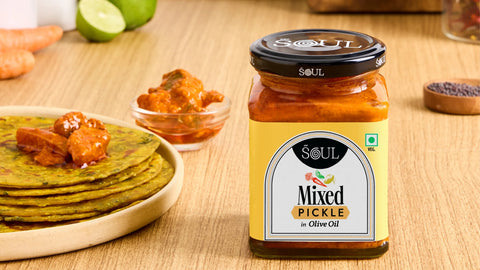In today’s fast-paced world, finding time for a nutritious breakfast can be a challenge. However, starting your day with a wholesome meal is crucial for energy, focus, and overall well-being. A well-balanced breakfast nourishes the body and fuels you for a productive day ahead. One such meal that combines taste, tradition, and nourishment is Moolchand Paratha—a variant of the traditional Indian flatbread.
Moolchand Paratha is a breakfast favorite that is both satisfying and versatile, ensuring that you can enjoy a hearty and nutritious start to your day. Made from whole wheat flour and cooked with ghee or butter, Moolchand Paratha provides essential nutrients and a rich, savory flavor. This flatbread has crispy layers, a soft interior, and a unique taste that will make it a beloved part of your breakfast routine.
The beauty of Moolchand Paratha lies in its versatility—it can be prepared plain or stuffed with a variety of flavorful fillings. The filling options are endless, from spiced potatoes and paneer to lentils and vegetables. The combination of the soft dough and delicious fillings makes Moolchand Paratha a meal that is both comforting and nutritious. Pairing it with fresh yogurt, pickles, or chutneys elevates the dish, ensuring that it becomes a wholesome, well-rounded breakfast.
Whether you’re looking for a simple daily meal or something special for the weekend, Moolchand Paratha provides a warm, satisfying start to your day.
Step-by-Step Moolchand Paratha Recipe
Creating a delicious homemade Moolchand Paratha is easy and rewarding. With this step-by-step recipe, you’ll enjoy a meal that is both flavorful and nourishing. Serve the paratha hot with butter, yogurt, or a tangy chutney for a truly authentic experience.
Ingredients:
For the Dough:
- 2 cups whole wheat flour
- ½ teaspoon salt
- Water (as needed for kneading)
- 1 teaspoon oil or ghee
For Cooking:
- Ghee or butter (for roasting)
Instructions:
Preparing the Dough:
- In a mixing bowl, combine whole wheat flour and salt.
- Gradually add water, kneading the mixture until you have a smooth, soft dough.
- Add a teaspoon of oil or ghee to the dough and knead it again until the dough is well-mixed and elastic.
- Cover the dough with a cloth or plastic wrap and let it rest for 20-30 minutes. Resting helps improve the texture and makes it easier to roll.
Making the Paratha:
- Once the dough has rested, divide it into equal-sized portions (about 6-8 portions, depending on the size of the paratha you want).
- Roll each portion of dough into a small ball.
- Flatten each ball and roll it into a small disc using a rolling pin. Ensure the disc is even in thickness.
- If you’re making stuffed parathas, add your desired filling (such as spiced potatoes, paneer, or vegetables) in the center of the disc. Fold the edges to cover the filling and roll it back into a flat, round shape.
- Heat a griddle or tawa over medium heat.
- Place the paratha on the preheated griddle and cook for 1-2 minutes, until golden brown spots appear. Flip the paratha and apply a small amount of ghee or butter on top.
- Flip again and press gently with a spatula to ensure even cooking. Cook until the paratha is golden and crisp on both sides.
- Remove the paratha from the griddle and serve hot with yogurt, butter, or a delicious chutney.
Tips for Perfect Moolchand Paratha
Dough Consistency:
- Soft Dough: Make sure the dough is soft to the touch. A smooth, non-sticky dough will make it easier to roll and will give you a better texture.
- Resting Time: Don’t skip the resting time! Allow the dough to rest for at least 20 minutes to enhance its elasticity and make it easier to work with.
Rolling Techniques:
- Gentle Pressure: When rolling out the dough, use light, even pressure. This prevents the dough from tearing and ensures smooth, even rolling.
- Light Dusting: Use minimal flour while rolling to avoid making the dough too dry. This also prevents the dough from sticking to the rolling surface.
Cooking Tips:
- Preheat the Griddle: Ensure your griddle is adequately preheated before placing the paratha on it. This helps the paratha cook evenly and gives it a crispy texture.
- Use Ghee or Butter: Cooking the paratha with ghee or butter adds flavor and makes the paratha crispy and golden brown.
- Press Gently: Lightly pressing the paratha with a spatula while cooking helps in even cooking and ensures it puffs up beautifully.
By following these simple tips, you can create perfect Moolchand Parathas every time.
Nutritional Benefits of Moolchand Paratha with Pickles and Chutneys
Moolchand Paratha, when paired with pickles and chutneys, becomes a powerhouse of nutrients. This combination offers a balanced mix of carbohydrates, proteins, fiber, vitamins, and healthy fats, making it a well-rounded meal to start your day. Here’s a breakdown of the nutritional benefits:
- Energy-Boosting Carbohydrates
- Whole wheat flour is a rich source of complex carbohydrates, which provide a steady release of energy throughout the day. These slow-digesting carbs help regulate blood sugar levels and keep you energized for longer periods.
- Moolchand Paratha ensures that you won’t experience an energy slump mid-morning, making it ideal for those with busy schedules.
- Protein for Strength and Muscle Health
- Whole wheat flour contains plant-based proteins, which are essential for muscle repair and overall growth.
- Pairing Moolchand Paratha with protein-rich sides like yogurt, paneer, or lentils further enhances the protein content, supporting muscle strength and immune function.
- Fiber for Digestion and Gut Health
- The fiber in whole wheat flour promotes healthy digestion and keeps your gut in good shape. Fiber aids in preventing constipation, regulating bowel movements, and supporting overall digestive health.
- A fiber-rich breakfast like Moolchand Paratha helps keep hunger at bay and maintains steady blood sugar levels.
- Vitamins and Minerals for Immunity and Well-Being
- Whole wheat is packed with B vitamins such as thiamine, niacin, and B6, which play a vital role in energy production and metabolism.
- Iron and folate found in whole wheat flour contribute to red blood cell production, reducing the risk of anemia.
- Potatoes, paneer, and other fillings provide additional vitamins like Vitamin C and Vitamin A, which boost immunity and promote good vision.
- Healthy Fats for Better Nutrient Absorption
- Ghee or butter used to cook Moolchand Paratha adds essential healthy fats. These fats enhance the absorption of fat-soluble vitamins like Vitamin A, D, E, and K, supporting overall health.
- Ghee also contains short-chain fatty acids that are beneficial for digestive health and provide a quick source of energy.
Conclusion
Moolchand Paratha is not just a delicious and comforting breakfast; it is also a nutritious meal that provides essential nutrients to fuel your body for the day ahead. Paired with pickles and chutneys, it becomes even more nourishing, offering a balanced combination of carbohydrates, protein, fiber, vitamins, and healthy fats. Whether you prefer it plain or stuffed with your favorite fillings, Moolchand Paratha is a versatile, satisfying meal that can be enjoyed every day. Start your morning on the right note with this wholesome, delicious dish.



